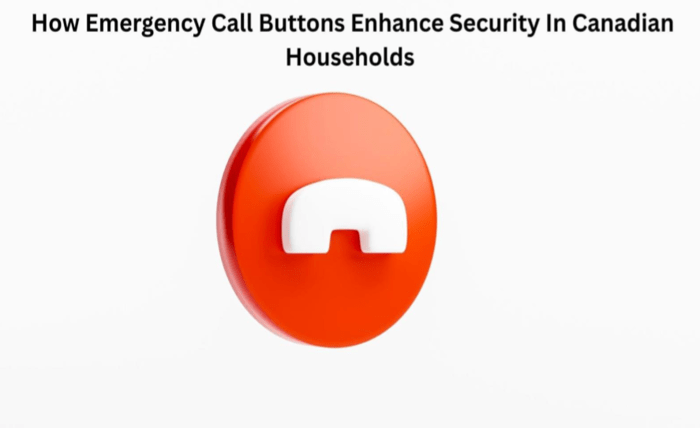Slips happen. So do episodes of dizziness, chest pains, or unexplained knocks at the door that don’t feel quite right. For many Canadians — particularly seniors or those with chronic health issues — the peace of mind that help is just the push of a button away is unmatched.
That peace isn’t only a matter of responding to emergencies. It’s about being comfortable in your own home. Emergency call buttons have evolved into compact, easy-to-use devices that blend into everyday life while offering a direct line to immediate support.
Whether it’s a medical scare or a safety issue, the ability to notify trained responders in a matter of seconds can make all the difference in outcomes — and peace of mind. Here is an examination of how these systems really add to home security, independence, and wellness, particularly for people living alone or aging in place.
1. A Silent Layer of Protection—Until You Need It
On the surface, an emergency call button may appear simple. It typically is a small pendant or wristband. But beneath that discreet design is a robust safety net.
When you push the button, it connects to an around-the-clock monitoring service. Within moments, a trained operator calls to check in, evaluates the situation, and calls emergency services if necessary.
You don’t even have to pick up a phone or speak if you can’t. Some Canadian emergency call button systems even include automatic fall detection, contacting support teams without any requirement for any intervention on your part.
That kind of passive readiness makes a big difference. It makes any room a safer place — particularly bathrooms, stairs, or kitchen areas, where most falls happen.
2. Staying Independent Without Compromise
Living independently doesn’t mean living without backup. For a lot of seniors, it isn’t the injury itself that they fear the most, but rather what will happen afterward. But being alone, with no way to call for help, brings anxiety that can chip away at confidence over time.
Emergency call buttons shift that equation. Suddenly, the fear of being alone becomes the decision to stay at home a bit longer, on your terms.
You can take that shower without worrying about any slip and fall. You can wander the house while knowing someone is a button-press away if something feels off.
The result?
More freedom. More autonomy. And way less “just in case” restrictions from friends and family who worry, but don’t want to hover.
3. Helping Caregivers Sleep Easier
Peace of mind is a benefit not just to the wearer but to the person’s family members, too. Adult children or family caregivers often carry invisible stress. They struggle between checking in constantly and respecting independence.
These emergency call systems can relieve that anxiety. Knowing there’s professional monitoring available 24/7 fills in the gaps when life pulls caregivers in different directions.
A few of the systems will even send out alerts or have mobile apps that are updated in real time for family members. So even if you’re a couple provinces over, you’ll know if something goes wrong — and that the trained professionals are already on it.
This will reduce caregiver burnout, help facilitate trust, and keep families connected without hovering.
4. Better Than a Phone—Especially in Emergencies
Phones are great tools— until you can no longer reach one. During an emergency, seconds count. A fall can cause someone to become disoriented or immobilized. Medical incidents like strokes or heart attacks can cause difficulty in speaking.
In such moments, even a short delay can make outcomes far worse. Call buttons are intended for such moments. Worn on the body and designed with large, easy-to-press surfaces, they are always accessible.
Certain devices even have built-in speakers and microphones, allowing for a two-way conversation with emergency personnel right through the device. Others provide GPS tracking, which can be a life-saving feature for a wanderer or an adventurer.
These devices are more responsive and reliable than landlines or cell phones, which are not simply better suited for urgent care.
5. A Solution That Adapts to Your Life
Modern emergency response systems aren’t one-size-fits-all. Some devices are waterproof for bath or shower use. Others are designed for outdoor coverage, ideal for gardening, walking, or daily errands.
There are even models that work without a landline, perfect for those who rely solely on mobile networks. More advanced systems incorporate fall detection, which uses sensors to automatically detect rapid motion changes.
That means you don’t even have to press a button to get help. If you fall and can’t speak or move, support is still on its way. Most setups also include a base station with a powerful speaker, allowing communication across multiple rooms.
You can go about your day, move freely through your home, and still be protected no matter where you are.
6. Confidence That Pays Off Every Day
While emergency call buttons are best known for responding to critical moments, their true value lies in prevention and confidence. When people feel safe, they live more actively.
Seniors who feel supported tend to walk more, socialize more, and participate in daily life with greater enthusiasm. That active lifestyle doesn’t just improve quality of life—it directly impacts long-term health outcomes, from mobility and cognition to mood and overall wellness.
Emergency buttons aren’t about fear—they’re about freedom.
Security Starts with Simplicity
All it takes is one push. No searching, no fumbling, no hesitation. Just an instant connection to help when it matters most.
Emergency call buttons offer something subtle but powerful: control. They protect, reassure, and empower—quietly standing by until needed. For many households across Canada, they’ve become not just safety tools, but everyday essentials.
And when life gets unpredictable, that’s the kind of simplicity you can count on.


